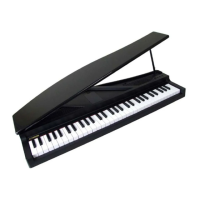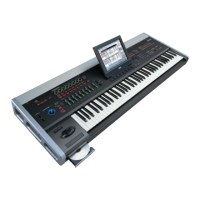PROG P4: Amp/EQ 4–3: Amp1 EG
63
Amp EG Curve
Different curve settings for up and down
You may find that different amounts of curvature are
suitable for segments which go up and segments which go
down.
For instance, a curve of 3 is a good default setting for
upward segments, such as Attack. On the other hand, a
curve of 6 or more is good for downward segments, such as
Decay and Release.
Attack [0L (Linear), 1...9, 10E (Exp/Log)]
This sets the curvature of the Attack segment - the transition
from the Start level to the Attack level.
Decay [0L (Linear), 1...9, 10E (Exp/Log)]
This sets the curvature of the Decay segment - the transition
from the Attack level to the Break level.
Slope [0L (Linear), 1...9, 10E (Exp/Log)]
This sets the curvature of the Slope segment - the transition
from the Break level to the Sustain level.
Rel (Release) [0L (Linear), 1...9, 10E (Exp/Log)]
This sets the curvature of the Release segment - the
transition from the Sustain level to the Release level.
4–3c: EG Level/Time Modulation
Level
These settings let you use any AMS source to control the
Level parameters of the EG. The Start, Attack, and Break
levels share a single AMS source, but can each have different
modulation intensities.
By using different settings for each of the three levels, you
can cause both subtle and dramatic changes to the EG shape,
as shown below.
Once an EG segment begins, it can’t be modulated
Once the EG has started a segment between two points, that
segment can no longer be modulated. This includes both the
time of the segment, and the level reached at the end of the
segment.
For more information, please see “Once an EG segment
begins, it can’t be modulated” on page 55.
Amp EG Level Modulation
AMS [List of AMS Sources]
This selects an AMS source to control the EG’s Level
parameters.
For a list of AMS sources, please see “AMS (Alternate
Modulation Source) List” on page 588.
St (Start) [–99...+99]
This controls the depth and direction of the AMS
modulation for the Start level.
For example, if you set the AMS source to Velocity and set St
(Start) to +99, the Start level will increase as you play harder.
If you instead set St (Start) to –99, the Start level will
decrease as you play harder.
At (Attack) [–99...+99]
This controls the depth and direction of the AMS
modulation for the Attack level.
Br (Break) [–99...+99]
This controls the depth and direction of the AMS
modulation for the Break level.
Time
These settings let you use three different AMS sources to
control the Time parameters of the EG. For each of the three
AMS sources, the Attack, Decay, Slope, and Release times
each have their own modulation intensities.
Amp EG Time Modulation
AMS1 [List of AMS Sources]
Selects the first AMS source to control the EG’s Time
parameters. Velocity and Keyboard Track can both be useful
here, for instance.
For a list of AMS sources, please see “AMS (Alternate
Modulation Source) List” on page 588.
At (Attack) [–99...+99]
This controls the depth and direction of the AMS
modulation for the Attack time.
For example, if you set the AMS source to Velocity and set
At (Attack) to +99, the Attack time will get much longer at
Curve=0L (Linear)
Curve=0L (Linear)
Curve=10E (Exp/Log)
Curve=10E (Exp/Log)
Original Shape
Positive AMS on Start and Break,
Negative AMS on Attack
Negative AMS on Start,
Attack, and Break
Volume
Time
Volume
Time
Volume
Time
Volume
Time
Positive AMS on Start,
Attack, and Break
Note-on Note-off Note-on Note-off Note-on Note-off
AMS=Velocity, Intensity = a positive (+) value
“Attack”= +, “Decay”= +,
“Slope”= +, “Release”= +
Softly played note.
Original Shape.
“Attack”= +, “Decay”= +,
“Slope”= +, “Release”= +
Strongly played note.
Times are longer.
Reaches Sustain
more slowly.
“Attack”=–, “Decay”=–,
“Slope”=–, “Release”=–
Strongly played note.
Times are shorter.
Reaches Sustain more
quickly.
